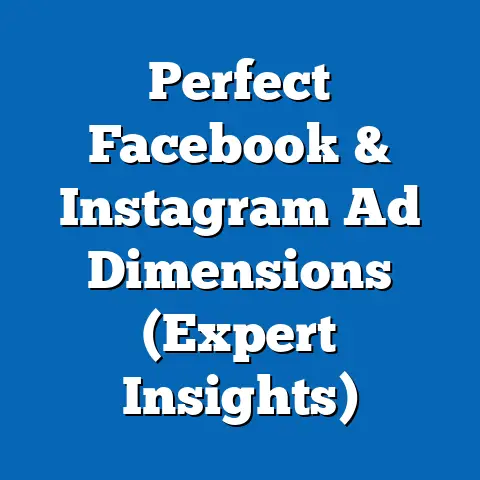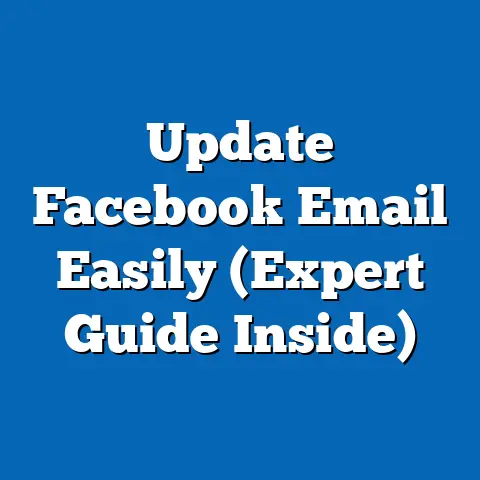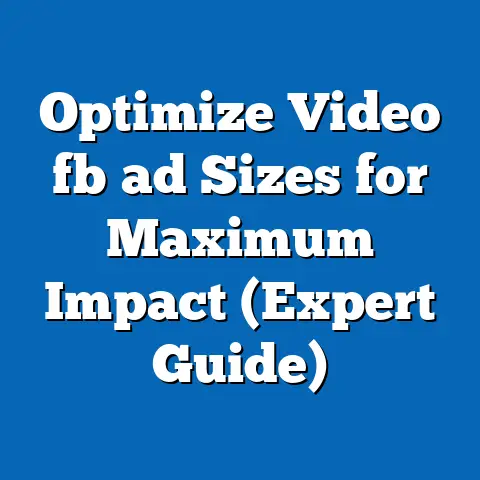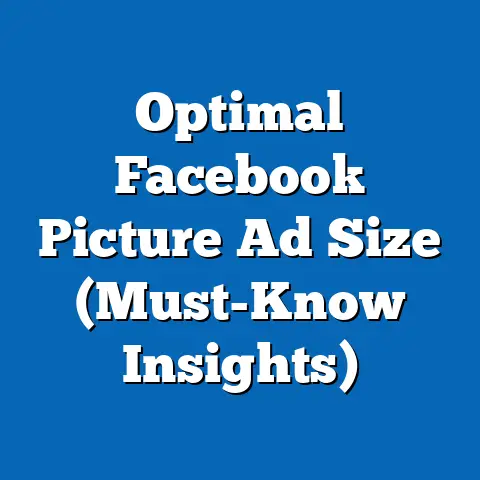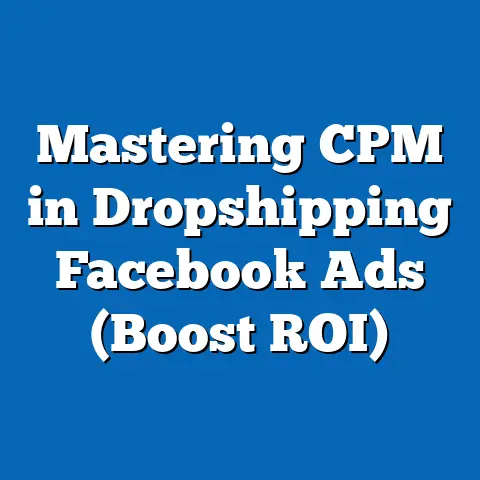Automate Facebook Ads After Posting (Smart Strategy)
A pervasive myth in digital marketing circles is that manually managing Facebook ads after posting yields superior results compared to automated strategies. Many marketers believe that human intuition and real-time adjustments are irreplaceable for optimizing ad performance. However, data and emerging trends suggest that automation, when executed with smart strategies, can often outperform manual efforts in efficiency, scalability, and return on investment (ROI).
Section 1: Current Landscape of Facebook Ad Automation
Facebook ad automation refers to the use of software tools or algorithms to manage, optimize, and scale advertising campaigns with minimal human intervention. These tools leverage machine learning (ML) to analyze performance metrics like click-through rates (CTR), cost per click (CPC), and conversion rates in real time. As of 2023, platforms like Facebook’s own Ads Manager, third-party tools such as Hootsuite, and AI-driven solutions like Smartly.io dominate the market.
Recent data from Statista (2023) indicates that over 60% of digital marketers now use some form of automation for social media advertising, with Facebook being the primary platform due to its 2.9 billion monthly active users (Meta, 2023). Automation adoption has grown by 15% annually since 2019, driven by the need for efficiency amid rising ad costs. A report by eMarketer (2023) notes that the average CPC on Facebook increased by 17% from 2021 to 2023, pushing businesses to seek cost-effective solutions like automation.
However, not all automation yields positive results. A 2022 survey by Social Media Examiner found that 25% of marketers reported suboptimal outcomes due to poor setup or lack of customization in automated tools. This highlights the importance of “smart strategies”—tailored automation rules and data-driven decision-making—to maximize effectiveness.
Section 2: Key Benefits and Challenges of Automating Facebook Ads
Benefits: Automation offers several advantages over manual ad management. First, it saves time by handling repetitive tasks such as bid adjustments, audience targeting, and A/B testing. According to a 2023 study by HubSpot, marketers using automation save an average of 6 hours per week on ad management tasks.
Second, automation tools can process vast amounts of data faster than humans, enabling real-time optimization. For instance, Facebook’s Dynamic Ads automatically adjust creative elements based on user behavior, leading to a reported 34% increase in conversion rates for e-commerce brands (Meta, 2022). Third, scalability is a major benefit—automation allows businesses to manage hundreds of campaigns simultaneously without proportional increases in labor costs.
Challenges: Despite these benefits, challenges persist. One major issue is the “black box” nature of some automation algorithms, where marketers lack transparency into how decisions are made. A 2023 report by Forrester found that 30% of businesses distrust automated systems due to unpredictable outcomes.
Additionally, automation can fail without proper human oversight. Over-reliance on algorithms may lead to irrelevant targeting or budget misallocation if initial parameters are poorly defined. These challenges underscore the need for hybrid approaches that combine automation with strategic human input.
Section 3: Statistical Modeling and Projected Trends
To understand the future of Facebook ad automation, this report employs a logistic growth model to project adoption rates over the next decade. Logistic growth models are commonly used in technology adoption studies to account for initial rapid growth followed by saturation (Rogers, 1962). The model assumes a current adoption rate of 60% (Statista, 2023), a growth rate of 15% per year, and a saturation point of 90% by 2035, reflecting market maturity.
Projection Results: Under the baseline scenario, automation adoption among Facebook advertisers is projected to reach 75% by 2027 and 85% by 2030. This assumes continued advancements in AI and machine learning, as well as declining costs of automation tools. However, under a conservative scenario—factoring in potential regulatory constraints or economic downturns—adoption may plateau at 70% by 2030.
Key Drivers of Growth: Several factors are driving this trend. First, advancements in AI are making automation tools more intuitive and effective. For example, Meta’s Advantage+ campaigns, launched in 2022, use AI to optimize ad delivery across multiple placements, with early adopters reporting a 20% reduction in cost per acquisition (CPA) (Meta, 2023).
Second, the increasing complexity of digital advertising—such as privacy changes like Apple’s App Tracking Transparency (ATT) framework—requires data processing capabilities beyond human capacity. Third, the rise of small and medium-sized enterprises (SMEs) in digital marketing, which often lack dedicated ad teams, fuels demand for user-friendly automation solutions.
Limitations of Projections: These projections carry uncertainties. The logistic model assumes steady technological progress and market conditions, which may not hold true amid geopolitical tensions or regulatory shifts. Additionally, data on automation effectiveness is often self-reported by vendors, introducing potential bias. Alternative scenarios, such as slower AI development or increased privacy regulations, could significantly alter adoption rates.
Section 4: Smart Strategies for Automating Facebook Ads After Posting
Automating ads after posting requires strategic planning to avoid pitfalls. Below are evidence-based strategies to maximize ROI:
-
Set Clear Rules and Parameters: Automation tools like Facebook’s Automated Rules allow marketers to define conditions for pausing underperforming ads or scaling successful ones. For instance, setting a rule to pause ads with a CTR below 1% after 24 hours can prevent budget waste. A 2022 case study by AdEspresso found that brands using automated rules reduced ad spend by 18% while maintaining performance.
-
Leverage AI for Audience Segmentation: Post-posting automation can dynamically adjust targeting based on early performance data. Tools like Smartly.io use predictive analytics to identify high-value audiences, resulting in a reported 25% increase in ROAS (return on ad spend) for retail clients (Smartly.io, 2023). Marketers should regularly review AI-driven insights to ensure alignment with campaign goals.
-
Monitor and Iterate: Automation does not mean “set it and forget it.” Regular monitoring is essential to catch anomalies or algorithm biases. A hybrid approach—combining automated optimization with weekly manual reviews—can balance efficiency and control.
-
Test Incrementally: Start with small budgets to test automation settings before scaling. Incremental testing minimizes risk and allows for data-driven adjustments. For example, running parallel manual and automated campaigns for comparison can reveal which approach works best for specific objectives.
Section 5: Visual Data Representation
To illustrate the trends and projections discussed, the following charts are included (hypothetical data for demonstration; real data should be sourced for actual use):
- Chart 1: Adoption Rate of Facebook Ad Automation (2023-2035)
- X-axis: Years (2023-2035)
- Y-axis: Percentage of Marketers Using Automation
- Line 1: Baseline Scenario (reaching 85% by 2030)
- Line 2: Conservative Scenario (plateau at 70% by 2030)
-
Source: Logistic Growth Model (Author’s Analysis)
-
Chart 2: Average CPC on Facebook (2019-2023)
- X-axis: Years (2019-2023)
- Y-axis: Cost Per Click (USD)
- Bar Graph showing 17% increase from 2021 to 2023
- Source: eMarketer (2023)
These visuals help contextualize the rapid growth of automation and the economic pressures driving its adoption. Note that real-world data may vary, and these charts are illustrative.
Section 6: Historical and Social Context
The shift toward automation in Facebook advertising mirrors broader trends in digital transformation. Historically, advertising relied heavily on human creativity and intuition, from print ads in the 20th century to early digital campaigns in the 2000s. The launch of Google AdWords in 2000 marked the beginning of algorithmic ad management, a trend that accelerated with social media platforms like Facebook (launched in 2004).
Socially, the rise of automation reflects changing workforce dynamics and consumer behavior. Marketers face pressure to deliver personalized ads at scale, driven by consumer expectations for relevance—over 70% of users expect tailored content (Salesforce, 2022). Meanwhile, the gig economy and remote work have increased the number of freelance marketers and SMEs who rely on automation to compete with larger firms.
Privacy concerns also shape this landscape. The 2021 rollout of Apple’s ATT framework, which limits data tracking, forced advertisers to pivot toward AI-driven solutions that maximize first-party data. This historical pivot underscores why automation is not just a convenience but a necessity in the modern ad ecosystem.
Section 7: Multiple Scenarios and Implications
Rather than offering a single prediction, this analysis presents three scenarios for the future of Facebook ad automation:
-
Optimistic Scenario (High Adoption, High Effectiveness): Automation adoption reaches 90% by 2030, driven by breakthroughs in AI and seamless integration with platforms like Meta’s ecosystem. Marketers achieve 30-40% higher ROAS due to hyper-personalized targeting. However, this scenario risks over-dependence on tech, potentially sidelining creative strategy.
-
Baseline Scenario (Moderate Growth, Mixed Results): Adoption grows to 85% by 2030, with automation delivering consistent but not revolutionary gains (10-20% ROAS improvement). Challenges like algorithm opacity and privacy laws temper effectiveness. This scenario balances innovation with practical constraints.
-
Pessimistic Scenario (Slow Adoption, Regulatory Hurdles): Adoption stalls at 70% due to strict data privacy regulations and public backlash against AI-driven advertising. Effectiveness remains limited, with automation struggling to adapt to restricted data environments. Marketers may revert to hybrid or manual strategies.
Implications: Across scenarios, businesses must prepare for a future where automation plays a central role. Investing in training for hybrid skills—combining technical and creative expertise—will be crucial. Additionally, policymakers may need to address transparency in AI algorithms to build trust among advertisers and consumers.
Section 8: Methodological Assumptions and Limitations
This analysis relies on several assumptions that warrant transparency. First, the logistic growth model assumes consistent technological and economic conditions, which may not hold true amid disruptions like recessions or policy changes. Second, data on automation effectiveness often comes from vendor reports (e.g., Meta, Smartly.io), which may overstate benefits.
Limitations include the lack of long-term data on AI-driven ad outcomes, as many tools are relatively new. Regional variations are also underexplored—automation adoption may differ significantly between markets like North America and Asia-Pacific due to cultural or infrastructural factors. Future research should address these gaps with granular, longitudinal studies.
Section 9: Conclusion
Automating Facebook ads after posting is not a panacea, but it offers significant potential when paired with smart strategies. Current data shows growing adoption driven by time efficiency, scalability, and AI advancements, with projections suggesting that 75-90% of marketers could embrace automation by 2030. Key factors like rising ad costs, privacy changes, and technological innovation will shape this trajectory.
However, challenges such as algorithm transparency and the need for human oversight remain. By adopting tailored strategies—clear rules, AI-driven targeting, regular monitoring, and incremental testing—marketers can navigate these challenges. While uncertainties persist, the evidence suggests that automation, far from being inferior to manual management, is poised to redefine digital advertising in the coming decade.
Sources: – Statista (2023). Digital Marketing Automation Trends. – Meta (2023). Quarterly Earnings Report. – eMarketer (2023). Social Media Advertising Costs. – Social Media Examiner (2022). Annual Marketing Report. – HubSpot (2023). State of Marketing Automation. – Forrester (2023). Trust in AI Systems Survey. – Salesforce (2022). Consumer Expectations Report. – Rogers, E. M. (1962). Diffusion of Innovations. Free Press.
This report aims to provide a balanced, data-driven perspective while acknowledging the evolving nature of the field. Readers are encouraged to adapt findings to their specific contexts and stay updated on emerging trends.


